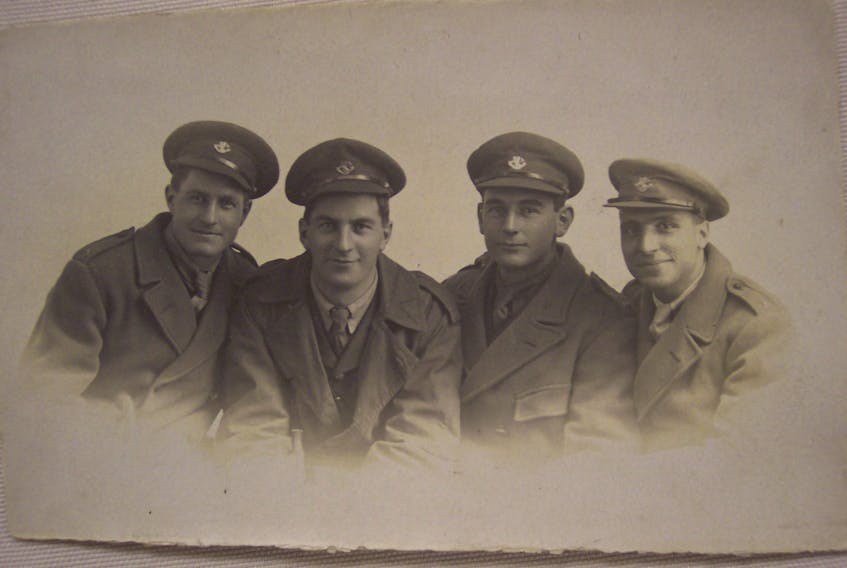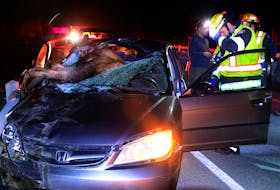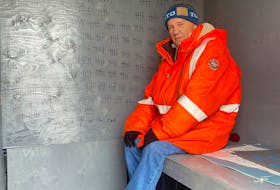Fredrick Wornell used to give a few dollars to his family every Remembrance Day.
He knew if it wasn’t for the Armistice agreed to in 1918, he wouldn’t have the chance.
Wornell was a member of the Royal Newfoundland Regiment during the First World War. He was born in Greenspond in 1897, and died in St. John’s in 1987.
Years after the war ended, he took to writing letters to catalogue some of the memories that still stayed fresh with him long after the fighting stopped.
One of the letters outlined a harrowing experience where, with his camp surrounded by Germans, the actions of William “White Line” Antle saved the battalion from certain death at the hands of the Germans.
Rob Paddon, Wornell’s great-grandson, says the letters have become part of his family’s lore.
He says it’s incredible to read a story from a relative about a moment where his bloodline could have stopped.
“It’s hard to describe. It’s an emotional experience. You can build a connection 100 years later through the stories and letters that he left behind,” Paddon said.
Paddon says the letters reveal how close the bonds between soldiers were when death was just around the corner.
“It was very much not about him — it was a tribute to a comrade. It emphasizes the comradery that they had. He was well into his 80s or 90s and to have such a vivid memory of that speaks volumes of the importance of that event.”
A few years ago, Paddon and his father, Terry Paddon, did the Trail of the Caribou and used the letters as a guide to retrace Wornell’s steps.
“This is one of the few that’s about combat. Most are just funny experiences,” he said.
“We went to the spot — as best we could figure — where he would have learned how to ride a bike.”
Paddon asked that, 100 years later, the story of the daring escape be printed in the newspaper. Here, we grant his wish.
Twitter: DavidMaherNL
Fredrick Wornell’s letter
Sixty-five years ago, Lord Kitchener pointed his long boney finger at us and said, “Join up, so you can tell your grandchildren what you did in ‘the Great War.’”
Here’s what one grandfather did.
It was April 13th, 1918, a bright clear beautiful day.
The 1st Battalion of the Royal Nfld. Regiment was surrounded. Billy Antle was a Battalion runner. It was his duty to take messages to Brigade Headquarters. He was sent off to Brigade to tell them the story. How in the world he ever got there in broad daylight, without being captured, nobody will ever know from that day to this, but he made it.
When he arrived at Brigade he met Billy Hall, and there hangs another story. Billy Hall was the Brigade runner. He was a Newfoundlander, who had served with the Nfld. Regiment, but, for some time past, had been attached to Brigade Headquarters, which was considered a fairly cushy job, as Brigade runner, but he wasn’t happy. He wanted to get back to his own Battalion, amongst his own friends from Newfoundland. So in September he applied to be transferred back. His application was approved. He was killed in action on October 14th, 1918.
The two Billies went and saw the Brigade Major and told him the story about the Battalion being surrounded. He went off and consulted with this staff. Shortly after, he came back and he asked Billy Antle,
“Billy, do you think you can get back again?”
“Oh yes Sir,” said Billy, “I think so.”
“Well,” said the B.M. “here’s what we are going to do. Of course, we have got to try and save the Battalion, get them out, what’s left of them, if we can. But obviously, you can’t do it in broad daylight, so we will wait until after dark and we will go in again. We will take a roll of white tape with us and we will unroll it as we go and, if we get in, and the Germans haven’t spotted the white tape in the meantime, it will help us to get out again, with, we hope, what’s left of the Battalion.”
It worked.
At about eleven o’clock that night, those of us up in the front line got the message. The Battalion is surrounded. Billy Antle is going to bring us out on a white line. Keep your mouth shut, your ears open, don’t make a sound and follow the leader.
And that’s how Billy Antle became known as “White Line Antle.” He saved the Battalion.
Billy, my friend, you were some man, some soldier. May your soul rest in peace.
The Epitaph
On this mount of dust and ashes.
Let no bitter tear be shed.
He is marching with his comrades.
Somewhere on the road ahead.
He has joined the unseen legions.
Sound for him no solemn Knoll.
He has heard the great Reveillé.
It is morning. All is well.
LEST WE FORGET
Lest we forget.
F.J. Wornell









